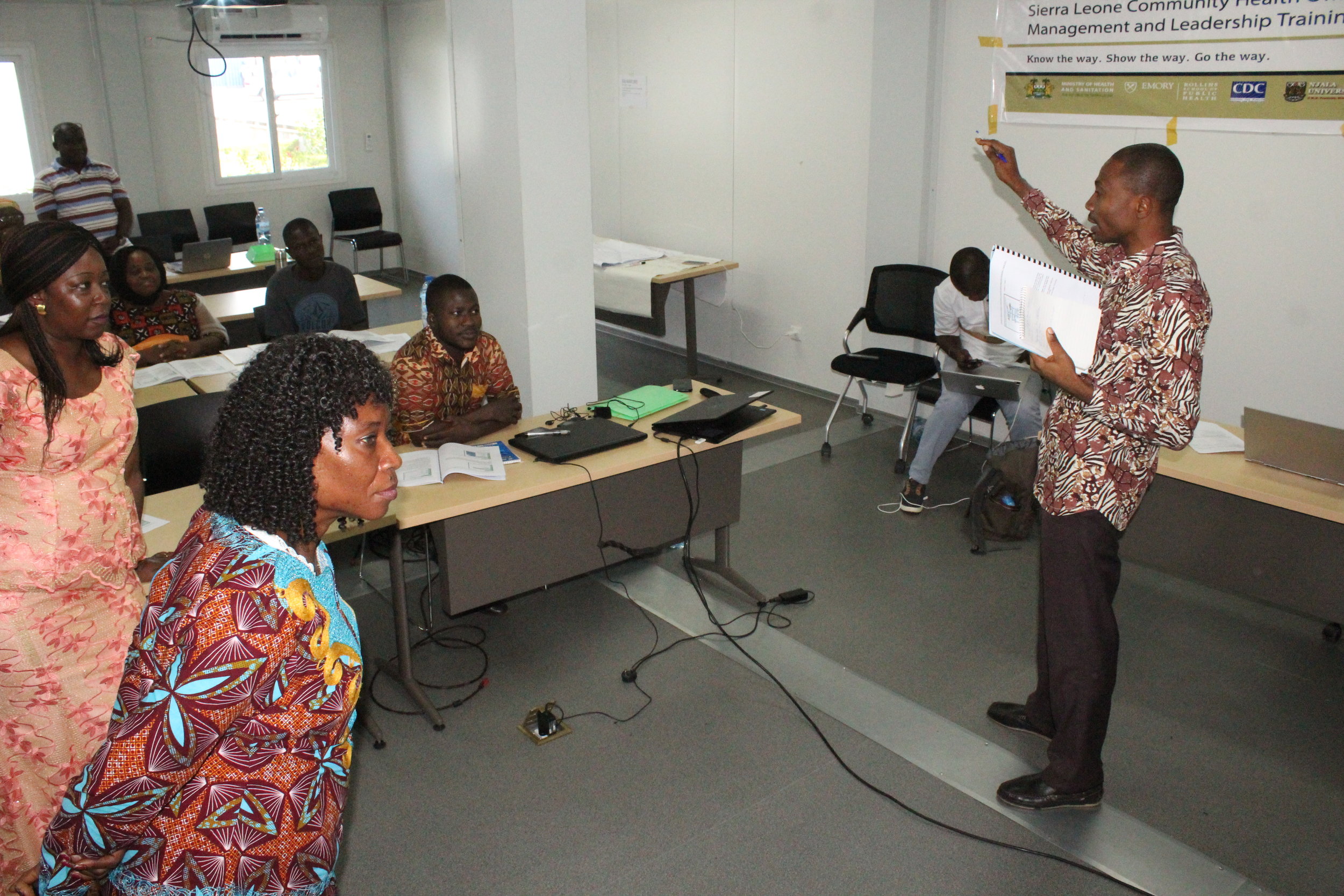By Sibongile Chikombore and Uche Ajene
The Ebola Virus Disease (EVD) exposed the need for increasing human resource capacity in Sierra Leone’s fragile health system. Prior to the launch of the Community Health Officers Management and Leadership Training Program (CHO-MLTP) in 2016, there was no formal training of that nature for health professionals in the country. The U.S. Centers for Disease Control and Prevention (CDC) collaborated with the Ministry of Health and Sanitation (MOHS), Njala University, Emory University, ICAP of Columbia University, and eHealth Africa (eHA) to develop a novel training program to address this need and ultimately improve health service delivery and health outcomes in Sierra Leone. CHOs working at Community Health Centers (CHCs) were targeted to be the first cadre to receive this public health management and leadership training, given their key role as first-line health service providers and chiefdom leaders.
The aim of the MLTP is to emphasize public health systems thinking and basic management principles needed to run effective health facilities and outreach services. The emphasis of the project is also to strengthen interpersonal communication and engagement with community leaders in order to develop practical and sustainable solutions to longstanding public health challenges.
In Sierra Leone, the Peripheral Health Units (PHU) comprise of Community Health Centres (CHCs), Community Health Posts (CHPs) and Maternal and Child Health Post (MCHPs). CHCs are headed by a Community Health Officer (CHO). The CHC is usually located at chiefdom headquarter level and provides services to a population ranging from 5,000-10,000 people. The CHP and MCHP are both usually located at smaller villages serving about 5000 or fewer people. They are manned by Community Health Assistants (CHAs) or Dispensers and Maternal and Child Health Aides (MCH-Aides) respectively.
CHO functions at the health center largely include administrative and clinical duties. The clinical responsibilities include treatment and appropriate referrals of medical, surgical and obstetric emergencies. They also supervise the activities of other PHUs in the chiefdom and report to the District Health Management Team (DHMT).
A total of ninety-nine (99) out of one hundred and seventy (170) CHOs across eight (8) districts (Bo, Kambia, Koinadugu, Bombali, Kenema, Kailahun, Western Area Urban and Rural) have been trained so far out of 12 targeted districts nationwide. The CHOs are trained in cohorts, comprised of CHOs from two districts.
As part of the effort towards sustainability and smooth transitioning of the CHO MLTP, selected staff from MOHS and Njala University are being trained as Trainers. Saidu Mansaray, CHO at Kroobay Community Health Center, is one of 99 CHOs who has been trained by eHA through the CHO-MLTP and was subsequently nominated to be part of the key individuals to form the Ministry of Health and Sanitation (MoHS), Training of Trainers (TOT) team. eHA conducted three TOT sessions for MOHS and Njala University staff who are the key MLTP implementing partners in Sierra Leone.
“I was part of the third cohort studies for the Sierra Leone CHO-MLTP. I was fortunate to be announced as one of the outstanding candidates in the CHO-MLTP Program.’”
The CHO MLTP has eleven (11) modules covered over a six-month period, with one of the key modules on Quality Improvement (QI). Before a CHO is eligible to graduate, he/she is expected to implement a QI project on either Improving Human Immunodeficiency Virus (HIV) or Hypertension Screening at their respective health facilities over a three month (minimum) period. The QI aims to address gaps or challenges in health service delivery at facility level on HIV or Hypertension during the MLTP, but the knowledge gained can be later used to apply the QI principles on other health challenges at the facility.
Through implementation of the QI, the CHO and PHU staff are able to work together as a team to brainstorm root causes of the health challenge being faced at the facility, come up with interventions, and prioritize interventions (based on ease of implementation and how important they are on a scale of one to five). From the prioritization matrix, the QI team from each facility then implements the interventions (also known as “change ideas”) within their own capacity, using the limited resources available.
Saidu implemented an HIV screening QI project at his health facility, where HIV testing rates were low. Prior to the implementation of the QI project, only 26% of eligible persons over 15 years old were tested for HIV. Saidu recognized that increased HIV testing would be necessary to ensure that members of his community know their HIV status and could receive appropriate care. Since the implementation of the QI project at his health facility, the HIV testing rate of eligible persons over 15 years has increased to 81%, and patients found to be positive have also started receiving HIV management care.
“This training has further helped me to manage both logistics and human resources at the facility. I am now able to use the little resources I have in my facility to produce the best of results.”
Saidu was also nominated to be a TOT participant after showcasing good leadership skills during his MLTP training in cohort three, has attended 3 TOT sessions organized by eHA. In December 2018, Saidu and other CHOs participated in the 3rd ToT session and was captured actively participating during the TOT workshop facilitating and presenting group work assignments to colleagues - see pictures attached below. After the TOT, Saidu and other TOT participants are expected to mentor other CHOs undergoing the MLTP nationwide.
“I am also currently being trained to pass on the skills learned from the CHO-MLTP Program to others.”



